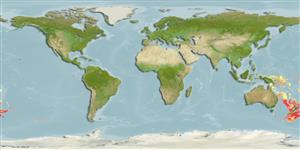Holocephali (Chimären, Seekatzen) (chimaeras) >
Chimaeriformes (Chimaeras) >
Chimaeridae (Shortnose chimaeras or ratfishes)
Etymology: Chimaera: Named for the mythological creature composed of parts of multiple animals, referring to their odd mix of characteristics (See ETYFish); lignaria: Latin for of or belonging to wood, referring to Kevin J. Dagit, woodworker, carpenter and “supporter of research on chimaeroid fishes in his spare time” (Sharks: An Eponym Dictionary identifies Dagit [misspelled Dadit] as Didier’s son; he was, in f (See ETYFish).
Eponymy: Kevin J Dagit was, at the time of the description, the describer’s husband. [...] (Ref. 128868), visit book page.
Environment: milieu / climate zone / Tiefenbereich / distribution range
Ökologie
seewasser bathydemersal; tiefenbereich 400 - 1800 m (Ref. 45044), usually 800 - 1800 m (Ref. 45044). Deep-water
Pacific: New Zealand and Tasmania. Commonly collected from the fishing grounds of the Tasman Rise, Hikurangi Trough, Challenger Plateau, and Lord Howe Rise.
Length at first maturity / Size / Gewicht / Alter
Geschlechtsreife: Lm 100.0 range ? - ? cm
Max length : 142 cm TL Männchen/unbestimmt; (Ref. 45044)
Kurzbeschreibung
Bestimmungsschlüssel | Morphologie | Morphometrie
Purplish color. Massive head with blunt snout. Preopercular and oral lateral line canals sharing a common branch. Males with bifurcated claspers, divided for the distal 1/3 of length, purple at the base with white fleshy tips. Skin firm and not deciduous.
Body shape (shape guide): elongated.
Males and females reach sexual maturity at 60-70 cm BDL (usually 100 cm TL) (Ref. 45044). Oviparous (Ref. 205). Eggs are encased in horny shells (Ref. 205).
Life cycle and mating behavior
Geschlechtsreife | Fortpflanzung | Ablaichen | Eier | Fecundity | Larven
Didier, D.A., 2002. Two new species of chimaeroid fishes from the southwestern Pacific Ocean (Holocephali, Chimaeridae). Ichthyol. Res. 49(4):299-306. (Ref. 45044)
IUCN Rote Liste Status (Ref. 130435: Version 2025-1)
Bedrohung für Menschen
Harmless
Nutzung durch Menschen
Tools
Zusatzinformationen
Download XML
Internet Quellen
Estimates based on models
Preferred temperature (Ref.
123201): 2.5 - 5.7, mean 3.6 °C (based on 978 cells).
Phylogenetic diversity index (Ref.
82804): PD
50 = 0.5000 [Uniqueness, from 0.5 = low to 2.0 = high].
Bayesian length-weight: a=0.00331 (0.00137 - 0.00798), b=3.07 (2.86 - 3.28), in cm total length, based on LWR estimates for this (Sub)family-body shape (Ref.
93245).
Trophic level (Ref.
69278): 3.7 ±0.6 se; based on size and trophs of closest relatives
Widerstandsfähigkeit (Ref.
120179): niedrig, Verdopplung der Population dauert 4,5 - 14 Jahre. (Assuming fecundity<100).
Fishing Vulnerability (Ref.
59153): Very high vulnerability (85 of 100).
🛈
